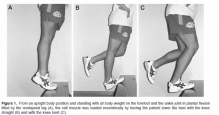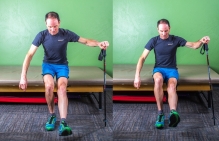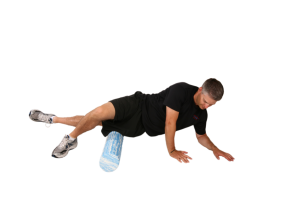Spring is nearly upon us and runners are beginning to increase training mileage and intensity to prepare for upcoming races. Preventing early season running injuries is possible through preventative exercise. Targeting the feet and lower leg, IT band and lateral leg, and hip regions will keep you running strong. A description of each body region and exercises to reduce injury risk in each is described below.
FOOT AND LOWER LEG WEAKNESS
Weakness in the intrinsic muscles of the foot result in overuse of the calf and increased Achilles tension. While a rapid increase in running mileage and intensity increases injury risk, targeted lower leg  strengthening will increase muscle and Achilles tendon tensile strength. Releasing foot and lower leg tension is important following a winter of snow running with reduced stride length. In addition to stretching and retrograde massage, active release techniques re-set the resting tone of a shortened or tight muscle. A physical therapist trained in active release techniques can demonstrate how to reduce the resting overactive muscle tone or tension synonymous with spring running.
strengthening will increase muscle and Achilles tendon tensile strength. Releasing foot and lower leg tension is important following a winter of snow running with reduced stride length. In addition to stretching and retrograde massage, active release techniques re-set the resting tone of a shortened or tight muscle. A physical therapist trained in active release techniques can demonstrate how to reduce the resting overactive muscle tone or tension synonymous with spring running.
*To strengthen your lower leg and foot musculature and avoid associated overuse injuries, add Heel Raises/Drops into your spring routine.
HIP WEAKNESS
Hip extension is driven by our gluteus maximus muscle. The hamstring often compensates for the gluteus maximus in the role of hip extension in distance runners. As running distance and inten sity increase, the hamstring begins to fatigue which may lead to cramping or muscle strain. Emphasizing gluteus maximus strength will reduce hamstring injury risk. Hip lateral stability is largely the job of the gluteus medius. In the absence of adequate lateral hip strength, runners compensate with pelvic drop, trunk side bending, knee valgus (knee collapses inward), and ankle-foot pronation during the foot strike portion of running.
sity increase, the hamstring begins to fatigue which may lead to cramping or muscle strain. Emphasizing gluteus maximus strength will reduce hamstring injury risk. Hip lateral stability is largely the job of the gluteus medius. In the absence of adequate lateral hip strength, runners compensate with pelvic drop, trunk side bending, knee valgus (knee collapses inward), and ankle-foot pronation during the foot strike portion of running.
*To strengthen your gluteal musculature and avoid associated overuse injuries, add Single Leg Squats or Single Leg Sit-Downs into your spring exercise routine.
ILIOTIBIAL BAND AND LATERAL LEG PAIN
Muscular weakness in the gluteus medius and gluteus maximus muscles results in overuse or over-compensation of the tensor fascia latae (TFL) and vastus lateralis. The thin TFL mu scle is located on the anterior and slightly lateral aspects of the hip. Overuse of the TFL, which flexes the hip and internally rotates the femur, leads to increased IT band tension and irritation of the insertion on the lateral knee. The vastus lateralis, however, is often ignored when evaluating and treating lateral leg or knee pain. Similarly, our sedentary, seated lifestyles cause hip flexor muscle shortening (TFL, psoas, iliacus, rectus femoris) which leads to an anterior tilt of the pelvis and ineffective gluteal muscle activation and function. Without adequate proximal stabilization via the gluteus medius and gluteus maximus musculature, foot strike often results in an internal rotation of the femur, inward motion of the knee, and increased lateral leg and IT band tension.
scle is located on the anterior and slightly lateral aspects of the hip. Overuse of the TFL, which flexes the hip and internally rotates the femur, leads to increased IT band tension and irritation of the insertion on the lateral knee. The vastus lateralis, however, is often ignored when evaluating and treating lateral leg or knee pain. Similarly, our sedentary, seated lifestyles cause hip flexor muscle shortening (TFL, psoas, iliacus, rectus femoris) which leads to an anterior tilt of the pelvis and ineffective gluteal muscle activation and function. Without adequate proximal stabilization via the gluteus medius and gluteus maximus musculature, foot strike often results in an internal rotation of the femur, inward motion of the knee, and increased lateral leg and IT band tension.
*To reduce lateral leg muscular tightness and IT band tension and avoid associated overuse injuries, add Lateral Leg Foam Rolling to decreased tightness in the lateral quadriceps musculature into your spring routine.
Visit the Sapphire Physical Therapy website (www.sapphirept.com) to learn more about our comprehensive running services and to sign up for the Sapphire PT monthly eNewsletter.
John Fiore, PT
Sapphire Physical Therapy
www.sapphirept.com
Barber FA, Sutker AN. Iliotibial band syndrome. Sports Med, 1992;14(2):144-8. Fairclough J, Hayashi K, Toumi H, et al. The functional anatomy of the iliotibial band during flexion and extension of the knee: implications for understanding iliotibial band syndrome. J Anat, March 2006;208(3):309-16.
*Image from Google search images




